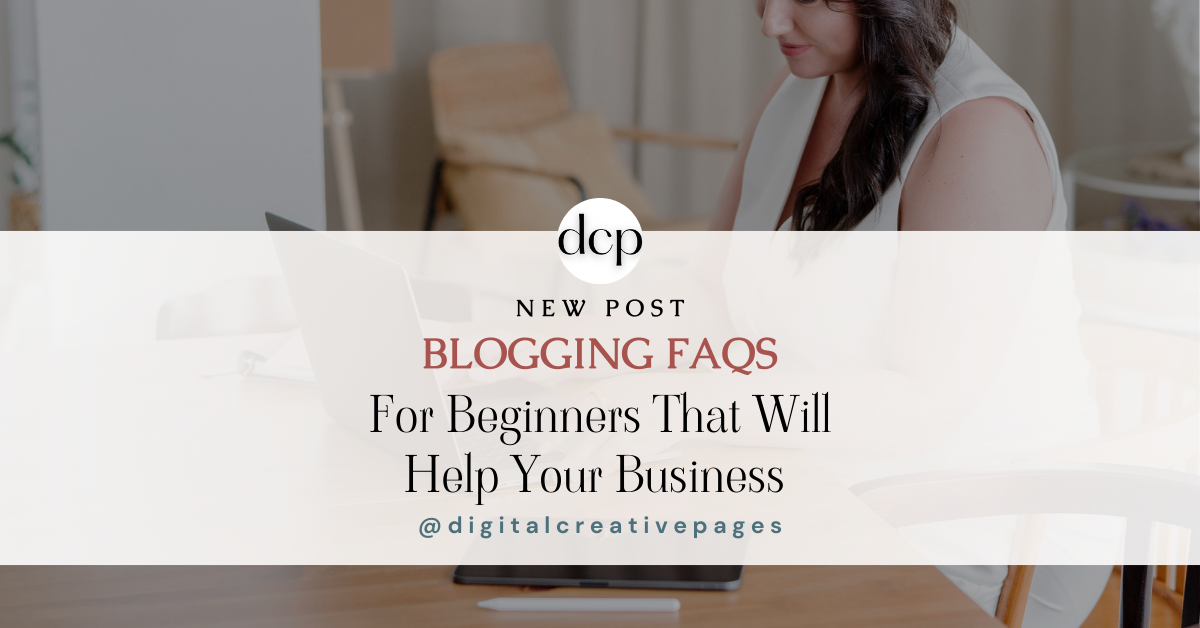Introduction
In today’s digital landscape, starting a blog for your business can be a game-changer. It’s an excellent way to establish your brand’s voice, showcase your expertise, and connect with your target audience. However, for many entrepreneurs and business owners, the prospect of launching a blog can be daunting. You’re likely bursting with questions about where to begin, how to manage it, and what to expect – The Blogging FAQs
Don’t worry – I’ve got you covered! In this comprehensive post, I’ll address the most common Blogging FAQs about starting a business blog. From choosing the perfect name to understanding the technical aspects, I’ll walk you through everything you need to know to launch your blog with confidence.
Pin this for later
What Should I Name My Blog?
Choosing the right name for your business blog is crucial. It’s often the first impression potential readers will have of your brand. Here are some tips to help you select the perfect name:
- Reflect your brand: Ensure the blog name aligns with your business name and values.
- Keep it simple: Choose a name that’s easy to spell and remember.
- Make it relevant: Include keywords related to your industry or niche.
- Be unique: Stand out from competitors with a distinctive name.
- Check availability: Ensure the name isn’t already taken or trademarked.
Consider brainstorming a list of potential names and asking for feedback from colleagues or target audience members. Remember, your blog name should resonate with your ideal readers and accurately represent your brand’s personality.
Which Domain Extension Should I Choose?
When it comes to domain extensions, .com is still the gold standard. It’s widely recognized and trusted by users worldwide. However, if your desired .com domain is unavailable, don’t despair! There are several alternative extensions that can work well for business blogs:
- .net: A popular alternative to .com, suitable for network-related businesses.
- .org: Ideal for non-profit organizations or community-focused blogs.
- .co: A shorter version of .com, gaining popularity among startups.
- .io: Often used by tech companies and startups.
- .blog: Perfect for dedicated blog websites.
Industry-specific extensions like .tech, .design, or .marketing can also be effective if they align with your niche. Ultimately, choose an extension that complements your blog name and is easy for your audience to remember.
How Can I Avoid Copyright and Trademark Infringement?
Protecting yourself from copyright and trademark infringement is essential when starting a business blog. Follow these best practices:
- Create original content: Always produce your own unique content.
- Use royalty-free images: Utilize stock photo websites or create your own visuals.
- Attribute sources: When referencing others’ work, provide proper credit and links.
- Understand fair use: Familiarize yourself with fair use guidelines for quoting or referencing copyrighted material.
- Conduct trademark searches: Before finalizing your blog name or logo, search trademark databases to avoid conflicts.
- Use disclaimers: Include appropriate disclaimers on your blog to protect yourself legally.
When in doubt, consult with a legal professional specializing in intellectual property to ensure you’re not infringing on anyone’s rights.
Related Post: 6 Free Sites For Aesthetic Pictures For Your Blog
How Can I Manage a Blog If I Don’t Know Technical Aspects?
Don’t let a lack of technical knowledge hold you back from starting a blog! Here are some strategies to help you manage your blog effectively:
- Choose a user-friendly platform: Opt for blogging platforms like WordPress, which offer intuitive interfaces and extensive documentation.
- Utilize drag-and-drop builders: Many themes and plugins provide easy-to-use visual editors for customizing your blog’s design.
- Take advantage of online tutorials: Countless free resources are available to help you learn basic blogging skills.
- Join blogging communities: Connect with other bloggers to share tips and ask for advice.
- Consider hiring a virtual assistant: If you’re short on time, a VA can handle technical tasks for you.
- Invest in managed hosting: Some hosting providers offer technical support and maintenance services.
Remember, you don’t need to be a tech guru to run a successful blog. Focus on creating valuable content, and don’t hesitate to seek help when needed.
Related Post: If you need me to manage some technical aspects of your blog, use my PA/VA services to send me a message. Let’s work together and not allow blogging to overwhelm you.
Why is WordPress the Best for Blogging?
WordPress stands out as the top choice for bloggers due to its versatility, user-friendliness, and robust features. It powers over 40% of all websites, offering unparalleled flexibility for businesses of all sizes. With a vast library of themes and plugins, WordPress allows you to customize your blog’s appearance and functionality without coding knowledge. Its SEO-friendly structure, regular updates, and strong community support make it an ideal platform for growing your business blog.
I use Showit to host my site since it uses WordPress for blogging. So it is the best amalgamation of creativity with function. Use my code DCP to get one 1.5 months free on Showit
What Would Be the Total Cost of Starting a Blog?
The cost of starting a blog can vary widely depending on your needs and choices. Here’s a breakdown of potential expenses:
- Domain name: $10-$20 per year
- Hosting: $3-$30+ per month (depending on the plan)
- WordPress theme: $0-$200 (one-time cost)
- Essential plugins: $0-$200 per year
- Professional logo design: $0-$500 (one-time cost)
- Content creation tools: $0-$50 per month
At the bare minimum, you could start a blog for less than $100 per year. However, investing in quality hosting, a premium theme, and essential tools can improve your blog’s performance and user experience. Budget accordingly based on your business goals and resources. Please verify the prices before you start your blog.
Can I Blog for Free Using WordPress.com?
Yes, you can start a blog for free using WordPress.com. However, free plans come with limitations:
- Your blog will have a wordpress.com subdomain (e.g., yourblog.wordpress.com).
- Limited customization options and themes.
- WordPress.com branding on your site.
- Restricted monetization options.
- Limited storage space.
While it’s a good way to test the waters, a free WordPress.com blog may not be ideal for long-term business use. As your blog grows, you’ll likely want to upgrade to a paid plan or self-hosted WordPress (WordPress.org) for more control and professional features.
How Do I Choose a Hosting Option?
Selecting the right hosting provider is crucial for your blog’s performance and reliability. Consider these factors when choosing a host:
- Uptime guarantee: Look for providers offering 99.9% or higher uptime.
- Loading speed: Fast-loading pages are crucial for user experience and SEO.
- Customer support: Ensure 24/7 support is available when you need help.
- Scalability: Choose a host that can accommodate your blog’s growth.
- Security features: Look for SSL certificates, regular backups, and malware scanning.
- Price: Compare plans to find the best value for your budget.
Popular hosting options for WordPress blogs include Bluehost, SiteGround, and WP Engine. Research and read reviews to find the best fit for your needs.
Related Post: Showit: Unlocking the Power of Creative Freedom
Is Blogging Dead or Super Saturated?
Contrary to some claims, blogging is far from dead. While the blogosphere has become more crowded, there’s still ample opportunity for businesses to succeed with blogging. The key is to:
- Find your unique voice and perspective.
- Focus on providing genuine value to your audience.
- Adapt to changing trends and user preferences.
- Integrate multimedia content like videos and podcasts.
- Leverage social media to amplify your blog’s reach.
Remember, a well-executed blog can significantly boost your business’s online presence and establish you as an industry authority.
How Long Will It Take to Start Making Money as a New Blogger?
The timeline for monetizing a new blog varies greatly depending on factors like your niche, content quality, and marketing efforts. While some bloggers see results within a few months, it’s more realistic to expect significant income after 6-12 months of consistent effort.
To accelerate your monetization journey:
- Focus on creating high-quality, valuable content.
- Build an email list from day one.
- Implement SEO best practices to increase organic traffic.
- Engage with your audience and build a community.
- Explore various monetization methods (affiliate marketing, sponsored content, digital products).
Remember, blogging is a long-term strategy. Patience and persistence are key to seeing financial returns.
How Many Hours Should I Devote to My New Blog?
The time investment for a successful blog can vary, but plan to dedicate at least 10-20 hours per week initially. This includes:
- Content creation: 5-10 hours
- Research and planning: 2-4 hours
- Promotion and networking: 2-4 hours
- Technical maintenance: 1-2 hours
As you become more efficient and your blog grows, you may need to invest more time or consider outsourcing some tasks. Consistency is more important than the exact number of hours – establish a sustainable routine that allows you to publish quality content regularly.
How Often Should I Publish Blog Posts?
The ideal publishing frequency depends on your resources and audience preferences. However, a good starting point for most business blogs is:
- 1-2 high-quality posts per week for the first few months
- 2-3 posts per week as you build momentum
- 3-4 posts per week for established blogs with a dedicated audience
Quality always trumps quantity. It’s better to publish one well-researched, valuable post per week than several rushed, low-quality articles. Monitor your analytics to understand what posting schedule resonates best with your audience.
How Often Should I Post on Pinterest in 2024?
Pinterest can be a powerful traffic driver for your blog. In 2024, aim for:
- 5-10 pins per day
- A mix of new content and repins
- Consistent daily pinning rather than sporadic bursts
Use scheduling tools like Tailwind to maintain a consistent presence without spending hours on the platform daily. Remember to create eye-catching, vertical images optimized for Pinterest to maximize engagement.
What Should I Do If I Run Out of Blog Ideas?
Writer’s block happens to every blogger. Here are strategies to overcome it:
- Keep an idea bank: Jot down ideas whenever inspiration strikes.
- Use keyword research tools: Discover what your audience is searching for.
- Analyze competitors: See what topics are popular in your niche.
- Ask your audience: Conduct surveys or polls to understand their interests.
- Repurpose existing content: Turn old posts into new formats (infographics, videos).
- Stay current: Follow industry news and trends for fresh topics.
- Collaborate: Invite guest bloggers or conduct interviews.
Remember, sometimes taking a short break can refresh your creativity and lead to new ideas.
How to Keep a Calm Mindset When I Don’t See Results in a Couple of Months?
Maintaining a positive outlook when results are slow can be challenging. Here’s how to stay motivated:
- Set realistic expectations: Understand that building a successful blog takes time.
- Focus on small wins: Celebrate milestones like your first comment or social share.
- Track progress: Use analytics to monitor growth, even if it’s gradual.
- Learn continuously: Use this time to improve your skills and knowledge.
- Connect with other bloggers: Share experiences and get support from peers.
- Remember your “why”: Reflect on the reasons you started blogging.
- Practice self-care: Take breaks and maintain a healthy work-life balance.
Enjoy every moment of your blogging journey. Remember, every successful blogger has faced challenges in the beginning. Stay consistent, keep learning, and trust in your journey.
Conclusion
Starting a business blog is an exciting venture that can significantly impact your brand’s growth and online presence. By addressing these common FAQs, I hope to have provided you with a solid foundation to begin your blogging journey. Remember, success in blogging comes from consistently creating valuable content, engaging with your audience, and staying adaptable in the ever-evolving digital landscape.
As you embark on this adventure, keep learning, stay patient, and don’t be afraid to experiment. Your unique voice and perspective are what will set your blog apart in the crowded online space. Happy blogging, and here’s to your success!
MY TOP POSTS
Stay connected outside my social media with my weekly Newsletter – Digital Content Pages
My introducer post – check out why I chose Showit as my website builder here
Use my code DCP to get one 1.5 months free on Showit
Get all the resources for your social media and digital marketing without breaking the bank from my DCP Shop here
Pin this for later


